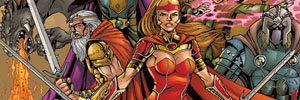6. The Nebula Sirens
 Over the ages, various space-faring cultures have encountered the mysterious “Nebula Sirens,† but have so far been unable to determine even the most basic means of communicating with the strange beings. Because of this, virtually nothing is known of their history, culture, or origins.
Over the ages, various space-faring cultures have encountered the mysterious “Nebula Sirens,† but have so far been unable to determine even the most basic means of communicating with the strange beings. Because of this, virtually nothing is known of their history, culture, or origins.
It appears that the creatures, while largely humanoid in appearance, are native to the near-vacuum of interstellar nebulae. It isn’t known whether they originated there, how exactly the survive, or how they have been seen in distant nebulae despite having no apparent means of interstellar travel.
Basic scans have suggested the creatures are made of dark matter. At first glance, they appear to be humanoid-shaped voids in the material of the nebula, revealing the blackness of space. In fact, they are perfectly black-surfaced, reflecting very little if any light.
Typically, it’s believed that there are more “sirens†that are female in appearance, but surveys have indicated that perhaps the females are simply more curious or social, and thus seen more often by explorers and other outsiders. Deeper in the nebulae, numbers of males– and indeed non-humanoid– “sirens†appear fairly even.
VISUAL DESIGN NOTES
The ideal design would show a female “siren†deep in swirling colorful nebular clouds, herself just a black void in the colorful gases. (Really the design is all about negative space.) In addition, a few more of the creatures could be shown in the background deeper in the nebula.
They should be shown with a curious and becoming demeanor, as if trying to greet the people inside a passing space vessel. Their intentions are fairly enigmatic, but not visibly hostile.
Created by Ian Struckhoff of Black Label Comics. (Artwork forthcoming.)
Category: Uncategorized










